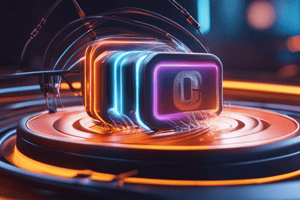Podcast
Questions and Answers
What type of charge is created when an object loses electrons?
What type of charge is created when an object loses electrons?
- Positive charge (correct)
- Negative charge
- Proton charge
- Neutral charge
Which term is associated with the process of an object gaining electrons?
Which term is associated with the process of an object gaining electrons?
- Protonation
- Neutronation
- Positronation
- Electronation (correct)
When a plastic rod is rubbed with fur, what type of charge does the plastic rod acquire?
When a plastic rod is rubbed with fur, what type of charge does the plastic rod acquire?
- Negative charge (correct)
- Positive charge
- Neutral charge
- Proton charge
Which method of charging involves the transfer of electrons from one object to another?
Which method of charging involves the transfer of electrons from one object to another?
If a glass rod is rubbed with silk, what type of charge does the glass rod acquire?
If a glass rod is rubbed with silk, what type of charge does the glass rod acquire?
What is the term for charging that occurs when two different materials come into contact and then separate?
What is the term for charging that occurs when two different materials come into contact and then separate?
Which charging method involves direct contact between a charged object and a neutral object?
Which charging method involves direct contact between a charged object and a neutral object?
What occurs in induction charging when a charged object is brought close to an uncharged object without direct contact?
What occurs in induction charging when a charged object is brought close to an uncharged object without direct contact?
Which method is commonly used in everyday life when walking on a carpet and then touching a metal doorknob?
Which method is commonly used in everyday life when walking on a carpet and then touching a metal doorknob?
What fundamental property of electricity can be better understood by studying the different types of electric charges and charging methods?
What fundamental property of electricity can be better understood by studying the different types of electric charges and charging methods?
Study Notes
Charges and Charging Process
Electric charges can be found in a variety of objects, from the smallest particles to the largest conductors. Understanding the types of charges and charging methods is crucial for various applications, including charging batteries and electronics, understanding electromagnetic phenomena, and more. In this article, we will discuss the different types of electric charges and the methods used to charge objects.
Types of Charges
Electric charges can be classified into two main types: positive and negative. These charges are created when electrons are either removed or added to an object.
Positive Charges
Positive charges are created when an object loses electrons. This is often referred to as "protonation" because it involves the transfer of protons (positively charged particles) from one object to another. For example, when a glass rod is rubbed with silk, the glass rod loses electrons and becomes positively charged.
Negative Charges
Negative charges are created when an object gains electrons. This is often referred to as "electronation" because it involves the transfer of electrons (negatively charged particles) from one object to another. For example, when a plastic rod is rubbed with fur, the plastic rod gains electrons and becomes negatively charged.
Charging Methods
There are three main methods for charging objects: friction, conduction, and induction.
Friction
Charging by friction, also known as "triboelectric charging," occurs when two different materials come into contact and then separate. As the materials separate, electrons can transfer from one material to the other, creating a charge. This method is commonly used in everyday life, such as when walking on a carpet and then touching a metal doorknob.
Conduction
Charging by conduction involves direct contact between a charged object and a neutral object. When the two objects come into contact, electrons can flow from the charged object to the neutral object, neutralizing the charge. This method is commonly used in charging batteries and electronic devices.
Induction
Charging by induction, also known as "electromagnetic induction," occurs when an uncharged object is brought close to a charged object without making direct contact. The charged object creates a magnetic field, which induces a current in the uncharged object. This method is commonly used in charging microphones and other electronic devices.
In conclusion, understanding the types of electric charges and the methods used to charge objects is essential for various applications in science, technology, and engineering. By studying these principles, we can gain a better understanding of the fundamental properties of electricity and how it can be harnessed for practical use.
Studying That Suits You
Use AI to generate personalized quizzes and flashcards to suit your learning preferences.
Description
Explore the types of electric charges, including positive and negative charges, and the methods used to charge objects such as friction, conduction, and induction. Understanding these concepts is crucial for applications like charging batteries, electronic devices, and electromagnetic phenomena.




